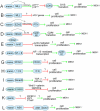Menin represses tumorigenesis via repressing cell proliferation
- PMID: 22016823
- PMCID: PMC3195934
Menin represses tumorigenesis via repressing cell proliferation
Abstract
Multiple endocrine neoplasia type 1 (MEN1) results from mutations in the tumor suppressor gene, MEN1, which encodes nuclear protein menin. Menin is important for suppressing tumorigenesis in various endocrine and certain non-endocrine tissues. Although menin suppresses MEN1 through a variety of mechanisms including regulating apoptosis and DNA repair, the role of menin in regulating cell proliferation is one of the best-studied functions. Here, we focus on reviewing various mechanisms underlying menin-mediated inhibition of cell proliferation. Menin inhibits cell proliferation to repress MEN1 through multiple mechanisms. 1) Menin interacts with various histonemodifying enzymes, such as MLL, EZH2 and HDACs, to affect gene transcription, leading to repression of cell proliferation. 2) Menin also interacts with various transcription factors, such as JunD, NF-κB, PPARγ and VDR, to induce or suppress gene transcription. As these various transcription factors are known to regulate cell proliferation, their interaction with menin may be relevant to menin's role in inhibiting cell proliferation. 3) Menin inhibits cell proliferation via TGF-β signaling and Wnt/β-catenin signaling pathways. 4) Menin represses certain pro-proliferative factors involved in endocrine tumors such as IGFBP-2, IGF2 and PTHrP to repress cell proliferation. 5) Menin affects cell cycle progression to inhibit cell proliferation. This review is helpful in our understanding of the comprehensive mechanisms whereby menin represses MEN1 through inhibiting cell proliferation.
Keywords: Menin; cell cycle; cell proliferation; epigenetics; gene transcription.
Figures

References
-
- Brandi ML, Gagel RF, Angeli A, Bilezikian JP, Beck-Peccoz P, Bordi C, Conte-Devolx B, Falchetti A, Gheri RG, Libroia A, Lips CJ, Lombardi G, Mannelli M, Pacini F, Ponder BA, Raue F, Skogseid B, Tamburrano G, Thakker RV, Thompson NW, Tomassetti P, Tonelli F, Wells SA, Jr, Marx SJ. Guidelines for diagnosis and therapy of MEN type 1 and type 2. J Clin Endocrinol Metab. 2001;86:5658–5671. - PubMed
-
- Gardner DG. Recent advances in multiple endocrine neoplasia syndromes. Adv Intern Med. 1997;42:597–627. - PubMed
-
- Trump D, Farren B, Wooding C, Pang JT, Besser GM, Buchanan KD, Edwards CR, Heath DA, Jackson CE, Jansen S, Lips K, Monson JP, O'Halloran D, Sampson J, Shalet SM, Wheeler MH, Zink A, Thakker RV. Clinical studies of multiple endocrine neoplasia type 1 (MEN1) Qjm. 1996;89:653–669. - PubMed
-
- Chandrasekharappa SC, Guru SC, Manickam P, Olufemi SE, Collins FS, Emmert-Buck MR, Debelenko LV, Zhuang Z, Lubensky IA, Liotta LA, Crabtree JS, Wang Y, Roe BA, Weisemann J, Boguski MS, Agarwal SK, Kester MB, Kim YS, Heppner C, Dong Q, Spiegel AM, Burns AL, Marx SJ. Positional cloning of the gene for multiple endocrine neoplasia-type 1. Science. 1997;276:404–407. - PubMed
Grants and funding
LinkOut - more resources
Full Text Sources
Other Literature Sources
Research Materials
Miscellaneous
